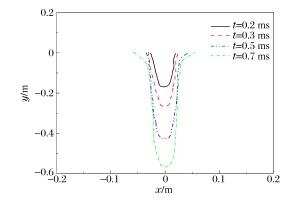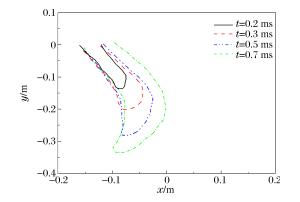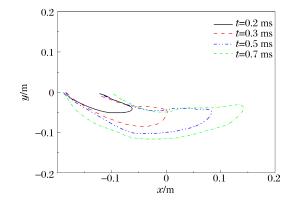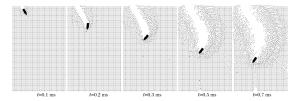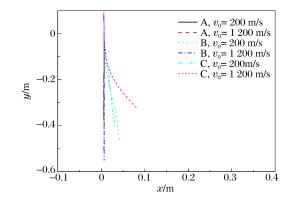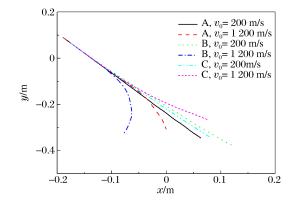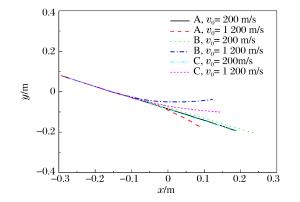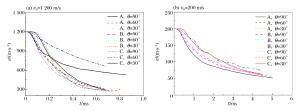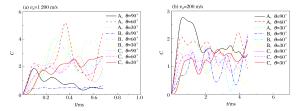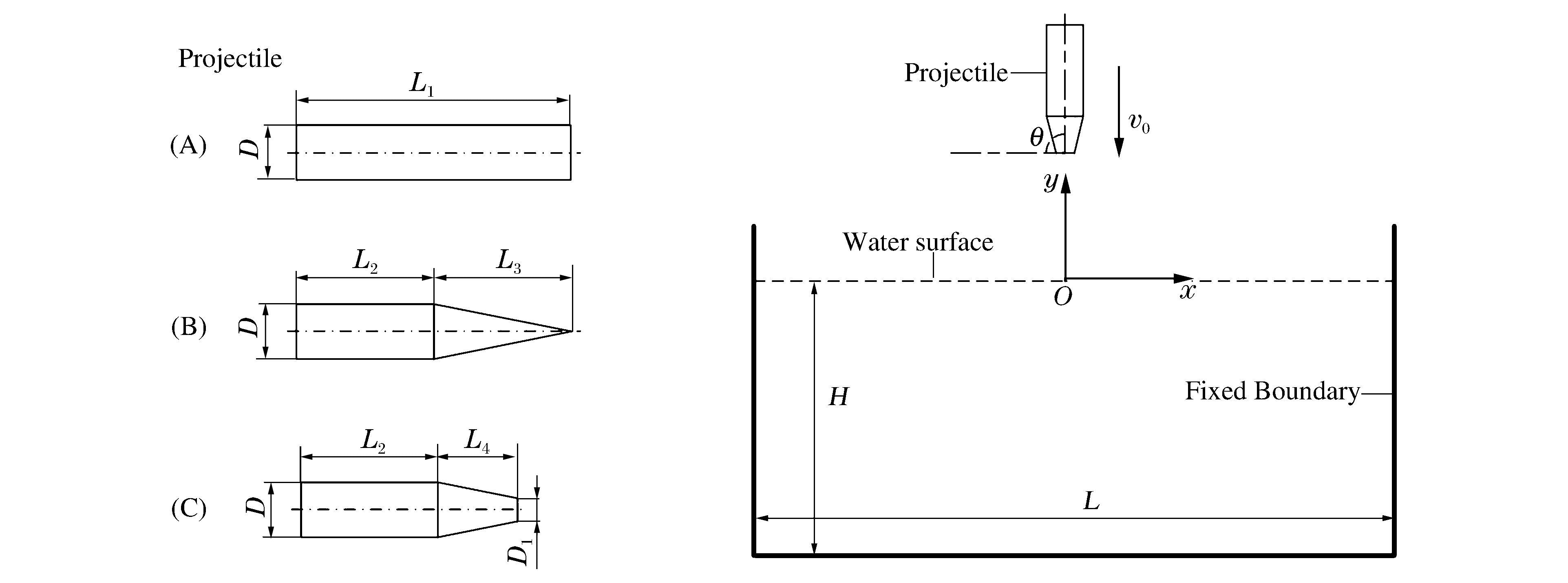SPH simulation on the behaviors of projectile water entry
-
摘要: 应用SPH方法研究弹丸入水过程中的动力学特征。利用拉格朗日形式的N-S方程自编SPH程序,建立弹丸入水的计算模型,赋予相应的材料参数及状态方程,研究弹丸外形、入水速度和角度等因素对入水过程的影响。模拟结果表明:空化泡的形态及发展规律主要由弹丸的运动姿态决定;弹道越稳定,阻力因数就越小,弹丸的存速就越大。SPH方法具有较强的自适应性,适用于研究弹丸入水的流固耦合问题。Abstract: In this work we investigated the dynamic behaviors of the projectile water entry using the SPH method. We developed our own SPH program based on the N-S equation of the Lagrange form and established a calculation model for the projectile water entry and, with corresponding material parameters and equation of state given, studied the influence of such factors as projectile shape, velocity and angle into the water on the process of the projectile water entry. The simulation results show that the formation and the development of the cavitation bubble are mainly determined by the projectile's state of motion: the more stable the projectile's trajectory, the smaller its drag coefficient, and the greater its sustained velocity. It is found that the SPH method has a high self-adaptability, for which it is applicable for studying the problems related with fluid-structure interaction occurring during the process of the projectile water entry.
-
Key words:
- fluid mechanics /
- underwater trajectory /
- SPH /
- drag coefficient
-
表 1 Mie-Grüneisen状态方程的材料参数
Table 1. Material parameters of Mie-Grüneisen equation of state
ρ0/(kg·m-3) c/(m·s-1) γ0 S1 S2 S3 a 1000 1480 0.5 2.56 1.986 1.227 0 -
[1] Putilin S I. Some features of dynamics of supercavitating models[J]. Applied Hydromechanics, 2000, 2(74):65-74. [2] Knapp R T, Daily J W, Hammitt F G. Cavitation[M]. NewYork: McGraw-Hill, 1970. [3] Franc J-P, Michel J-M. Fundamentals of cavitation[M]. The Netherlands: Kluwer Academic Publishers, 2004 [4] 曹伟, 王聪, 魏英杰, 等.自然超空泡形态特性的射弹试验研究[J].工程力学, 2006, 23(12):175-187. doi: 10.3969/j.issn.1000-4750.2006.12.031Cao Wei, Wang Cong, Wei Yingjie, et al. High-speed projectile experimental investigations on the characteristics of natural supercavitation[J]. Engineering Mechanics, 2006, 23(12):175-187. doi: 10.3969/j.issn.1000-4750.2006.12.031 [5] 易文俊, 王中原, 熊天红, 等.水下高速射弹超空泡减阻特性研究[J].弹道学报, 2008, 20(4):1-4. http://d.old.wanfangdata.com.cn/Periodical/ddxb200804001Yi Wenjun, Wang Zhongyuan, Xiong Tianhong, et al. Research on drag reduction characteristics of a underwater high-speed supercavitation projectile[J]. Journal of Ballistics, 2008, 20(4): 1-4. http://d.old.wanfangdata.com.cn/Periodical/ddxb200804001 [6] 安伟光, 蒋运华, 安海.运动体高速入水非定常过程研究[J].工程力学, 2011, 28(3):251-256. http://www.cnki.com.cn/Article/CJFDTOTAL-GCLX201103039.htmAn Weiguang, Jiang Yunhua, An Hai. The unsteady water entry process study of high-speed vehicle[J]. Engineering Mechanics, 2011, 28(3):251-256. http://www.cnki.com.cn/Article/CJFDTOTAL-GCLX201103039.htm [7] Chen J K, Beraun J E. A generalized smoothed particle hydrodynamic method for nonlinear dynamic problems[J]. Computer Methods in Applied Mechanics and Engineering, 2000, 190(1):225-239. [8] Cleary P W, Prakash M, Ha J. Novel applications of smoothed particle hydrodynamics (SPH) in metal forming[J]. Journal of Materials Processing Technology, 2006, 177(1):41-48. http://www.wanfangdata.com.cn/details/detail.do?_type=perio&id=2912c16d0874a46a1bd798037e48ad58 [9] Shin Y S, Lee M, Lam K Y, et al. Modeling mitigation effects of watershield on shock wave[J]. Shock and Vibration, 1998, 5(4):225-234. doi: 10.1155/1998/782032 [10] Libersky L D, Petschek A G. High strain Lagrangian hydrodynamics: A three-dimensional SPH code for dynamic material response[J]. Journal of Computational Physics, 1993, 109(1):67-75. [11] Lucy L B. A numerical approach to the testing of the fission hypothesis[J]. The Astronomical Journal, 1977, 82(12):1013-1024. doi: 10.1086-112164/ [12] Liu G R, Liu M B. Smoothed particle hydrodynamics: A meshfree particle method[M]. German: Springer Berlin /Heidelberg, 2004:1-491. [13] Monaghan J J. Particle methods for hydrodynamic[J]. Computer Physics Report, 1985, 3(2):71-124. http://d.old.wanfangdata.com.cn/Periodical/nygcxb201512013 [14] Monaghan J J. On the problem of penetration in particle menthods[J]. Journal of Computer Physics, 1989, 82(1):1-15. [15] Monaghan J J. Smoothed particle hydrodynamics[J]. Reports on Progress in Physics, 2005, 68(8):1703-1759. doi: 10.1088/0034-4885/68/8/R01 -






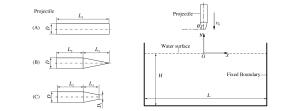
 下载:
下载:
